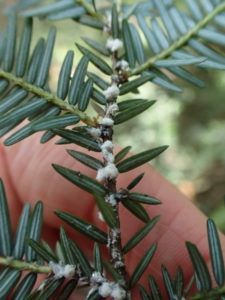Michigan’s Terrestrial Invasive Species Management Plan Spotlight: Hemlock Woolly Adelgid (HWA)

According to a report by Michigan’s Terrestrial Invasive Species Management Plan: “Terrestrial invasive species (TIS) — non-native plants, insects, animals and diseases that harm the environment, economy and human health — are taking a toll on Michigan. Michigan’s Terrestrial Invasive Species State Management Plan provides a strategy for preventing introductions of invasive species on land and reducing impacts from those that have arrived.”
At MUCC, we combine education, advocacy and on-the-ground work to conserve and protect our natural resources. Speaking to all who read this blog, our rich natural resources are under a constant threat from invasive species. As stewards of our land, it is our job to become educated about these invasive species and take appropriate action to manage and eradicate them. We at MUCC support Michigan’s Terrestrial Invasive Species Management Plan so that Michigan citizens may continue to enjoy their natural resources for generations to come. This blog post highlights one invasive that has made its way onto the state’s top priority list: the hemlock woolly adelgid (HWA).
What is the HWA?
Hemlock woolly adelgids are dark brown/red colored insects that are not the easiest to spot at less than 1/16 of an inch. The easiest way to identify an HWA infestation is by the white wool-like wax seen on the base of hemlock needles. It is important to note that the wool-like white masses of HWA can be mistaken for the frothy white masses of the spittlebug (know the difference, click this LINK ). When HWA feed, they secrete white fluff from pores in their body to protect themselves and their eggs. However, you can only see the white secretion from late fall to early summer on the underside of shoots. Needles from hemlock trees with a heavy infestation of HWA become dry and will drop from the infected trees. The exact introduction of HWA to Michigan is unknown but was thought to be introduced by a hemlock tree that was transferred from an infected area outside of Michigan and planted on the west side of the state. The core infection region is still located on the western side of the state and has the potential to spread throughout the eastern hemlock population.
-Read more about the HWA life cycle HERE
What are the negative impacts of HWA?
In Michigan, HWA only utilize eastern hemlock trees as hosts. They feed through specialized mouthparts that enable them to pierce the base of a hemlock needle and suck out nutrients from the cells in the shoot of the hemlock tree. According to a report by Michigan’s Terrestrial Invasive Species Management Plan: “Toxic saliva injected by the adelgids may also trigger a hypersensitive response by the tree, which slows water transport.” As the infestation progresses, trees may fail to set new buds. Hemlock trees may then lose their vigor and take on a grayish-green appearance. Hemlocks can be killed by HWA in as little as four years.
Why is managing HWA important?
 HWA is native to Japan and possibly China, where they feed on western and asian hemlock that have evolved a resistance to the insect and have natural predators to control their population. Eastern hemlocks are not resistant to HWA and no natural predators exist in the region to control the population of the invasive. The crawlers (see HWA life cycle) can increase the infection rate of HWA by being transported by wind, birds and other animals to surrounding hemlock trees. Due to the immediate threat of expansion by the invasive, it is important that we manage HWA for the future of our eastern hemlock population in Michigan.
HWA is native to Japan and possibly China, where they feed on western and asian hemlock that have evolved a resistance to the insect and have natural predators to control their population. Eastern hemlocks are not resistant to HWA and no natural predators exist in the region to control the population of the invasive. The crawlers (see HWA life cycle) can increase the infection rate of HWA by being transported by wind, birds and other animals to surrounding hemlock trees. Due to the immediate threat of expansion by the invasive, it is important that we manage HWA for the future of our eastern hemlock population in Michigan.
Eastern hemlocks are important to Michigan’s mesic northern forests. Regarding wildlife, they provide shelter and food for deer during the winter months and provide year-round habitat for birds and other small mammals. Their seed-producing cones also serve as foraging material for a variety of wildlife. Hemlocks help keep our streams cool from their low hanging branches over river systems, which benefits many species of trout.
Wh at YOU can do
“If hemlocks grow on your property or if you manage hemlock trees in the forest or landscape settings, periodically check the shoots for evidence of HWA. If you suspect a tree may be infested, please collect digital images of infested shoots and the tree(s). Also, be sure to note the location of the affected tree(s). Contact the Michigan Department of Agriculture and Rural Development by phone at 800-292-3939 or by email at MDA-Info@michigan. gov.”
“Landscapers, arborists and others who prune, trim or fell hemlock trees should be especially careful to dispose of this material and clean their equipment to avoid spreading HWA into new areas.”
Read more about how you can protect hemlock trees HERE
Educational Materials
The Michigan Invasive Species Management Plan was developed by the Michigan Department of Agriculture and Rural Development, Michigan Department of Environmental Quality, Michigan Department of Natural Resources, Michigan Department of Transportation, and other conservation affiliates.
Recent Posts




